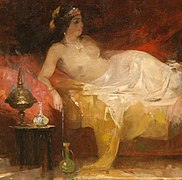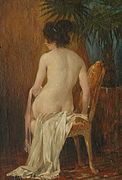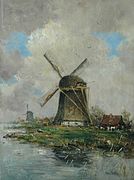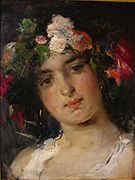Hobbe Smith
This article needs additional citations for verification. (January 2016) |

Hobbe Smith (7 December 1862, Witmarsum - 1 May 1942, Amsterdam) was a Dutch painter, watercolorist and graphic designer, in the Post-Impressionist style.
Biography
His father was a house painter. He was apprenticed to a lithographer at a young age and attended drawing classes at the Quellinusschool.
Thanks to a wealthy patron who liked his work, he was able to receive a Royal Scholarship and studied at the Rijksakademie with August Allebé. Later, he took classes at the Royal Academy of Fine Arts in Antwerp with Charles Verlat.[1]
He painted a wide variety of subjects, including nudes, still-lifes, portraits, historical scenes and seascapes, influenced by Jacob Maris. In 1888, he won the Willink van Collenprijs. International fame arrived after an exhibition at the Pulchri Studio in 1902. He received a gold medal from Queen Wilhelmina in 1917. He was also a member of Arti et Amicitiae.[1]
- Works by Hobbe Smith
-
Odalisque
-
Nude
-
Bathing Nymphs
-
Windmill
-
Portrait with Floral Wreath
References
- ^ a b Profile @ the Rijksbureau voor Kunsthistorische Documentatie.
Further reading
- Norbert Middelkoop, Gezicht op het IJ: Hobbe Smith en de Amsterdamse haven in 1913, Amsterdam Museum, 2013 ISBN 90-7136-110-1
External links





